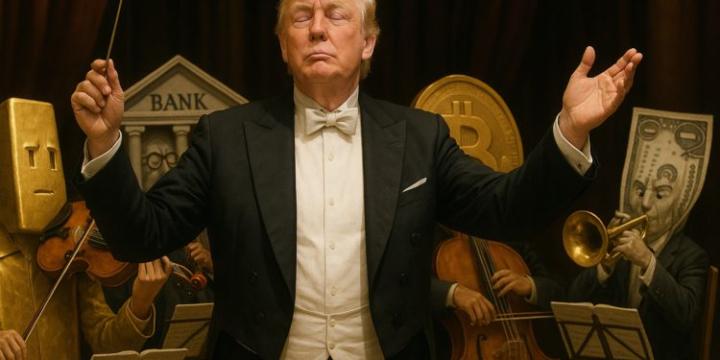Original | Odaily ([@OdailyChina](https://x.com/OdailyChina))
Author | Wenser ([@wenser 2010](https://x.com/wenser2010))
Original Title: One Year After the Bitcoin Conference, Did Trump Fulfill His Previous Promises?
In July 2024, Trump delivered a passionate speech at the Bitcoin Conference in Nashville, Tennessee, confidently outlining his "Crypto Policy 2.0" blueprint. Subsequently, the crypto community, representing about one-fifth of the US population, gradually shifted to support Trump, establishing a significant advantage in the November presidential election. One year later, over 6 months after taking office, it might be time to review Trump's "Crypto Policy Implementation and Progress" to examine whether he truly fulfilled his promises and gain insight into the future of US crypto policy. Odaily will organize and summarize the crypto-related policies and bills advanced in the past six months for readers' reference.
First Action Upon Taking Office - Firing Gary Gensler, Progress: Completed
As the SEC Chairman during the Biden administration, Gary Gensler was despised by the entire industry due to his extremely unfriendly enforcement attitude towards the crypto industry. Trump viewed him as a "target" and pledged to fire him on his first day in office and appoint a crypto-friendly new SEC Chairman.
Currently, Trump has followed through on this promise. On January 21st, the SEC officially announced Gary Gensler's departure. Moreover, Gensler's "political legacy" was liquidated in June - the SEC formally withdrew several proposed rules for stricter regulation of DeFi and crypto custody implemented under his leadership.
In this aspect, Trump's dismissal of Gary Gensler was widely celebrated.
Additionally, in March, Coinbase launched an investigation into Gary Gensler's expenditure in crypto enforcement actions. The investigation is ongoing.
Second Action - Establishing a Government Bitcoin Strategic Reserve, Progress: Partially Completed
In March, Trump signed an executive order establishing two different digital asset storage mechanisms:
1. Strategic Reserve storing only Bitcoin (BTC) - Initial funding: Approximately 200,000 BTC seized by the government over years - Unique authorization: Treasury Secretary Bessent and Commerce Secretary Lutnick are authorized to explore acquiring more Bitcoin without burdening taxpayers
2. Digital Asset Stockpile containing assets beyond Bitcoin - May include XRP, ADA, ETH, SOL, and other assets - Managed by the Treasury Department - Requires a comprehensive audit of government-held digital assets
Third Action - Ending "Operation Choke Point 2.0"; Prohibiting CBDC; Establishing Stablecoin Regulation Framework, Progress: Appointed White House AI and Crypto Advisor; Anti-CBDC Bill Passed House Vote; GENIUS Act Approved
Currently, this is only partially completed. Trump previously appointed David Sacks as the White House AI and Crypto Advisor to manage crypto policy research and formulation.
The Anti-CBDC Monitoring Act (S.1124) has passed the House vote and is awaiting Senate review. The GENIUS stablecoin regulation act is also pending final approval.
On July 19th, US President Trump has officially signed the "GENIUS Act", marking the first federal regulation related to crypto assets. The act requires stablecoins to be 100% backed by US dollars or equivalent liquid assets, and mandates annual audits for issuers with a market cap exceeding $50 billion, while also establishing regulatory guidelines for offshore issuance. Executives from Circle, Tether, and Coinbase attended the signing ceremony, with Trump stating this move will "establish the United States' leadership in global finance and crypto technology". Trump's signing of the GENIUS Act **Fourth campaign promise - Ensuring the US becomes a global crypto hub and Bitcoin superpower, progress: not yet completed** Ultimately, the most important promise Trump made was to "ensure the US becomes a global crypto system and Bitcoin superpower", which currently remains a challenging goal. On one hand, the Federal Reserve has not yet signaled interest rate cuts, and the crypto market's liquidity remains relatively limited. On the other hand, despite Circle's listing as the "first stablecoin stock" and US-listed companies initiating crypto reserve trends, the US is still far from completely removing unnecessary crypto regulations. Additionally, Trump's "tariff trade war" launched in April has somewhat impacted this vision. As a crucial component of the global economic system, US tariff policies have wide-ranging effects, and inconsistent tariff policies make it difficult for global capital to confidently join the US crypto market's liquidity. Meanwhile, looking back at Trump's Bitcoin conference speech last year, we belatedly realize that his political relationship with Musk was destined to end. He once mentioned: "Not everyone must own an electric vehicle. I told him (Musk). So we will cancel that mandatory regulation. Some people like gasoline cars, some like hybrid cars, some like electric cars. They're all good. I think Elon has done great, and he understands. If he didn't understand, he might not have supported me." Now, with the gradual implementation of the "Big and Beautiful Act", it seems somewhat nostalgic. Of course, making the US a global crypto hub is not an overnight task. Whether Trump can successfully fulfill his promise during his term requires evaluating three standards: First, when the US government will buy its first BTC under federal government name; Second, whether the proportion of companies establishing crypto currency treasury reserves in the US stock market can achieve a breakthrough; Third, whether the crypto market can again achieve exponential growth dependent on the US market. If at least two of these three standards are met, Trump's vision of a "global crypto hub" or "Bitcoin superpower" could be considered successful; otherwise, more effort is still needed.






